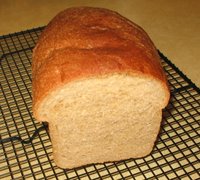My recipe for homemade bread made from freshly ground wheat
Okay, with lots of people coming in a couple of months, and with today being a cool, rainy day it seemed a good time to make up and freeze an extra batch of my made-from-freshly-ground-wheat homemade bread. Except then I dropped the recipe card into the yeasty water and later part of the container that catches the freshly-ground flour into the yeasty and oily water. Oops.
Note to self: "Make another copy of this recipe and post it on the internet so that it can be accessed from nearly anywhere in the world so that when you finally lose the recipe card altogether, you'll be able to find out how to make your bread and the poor OC and I won't go into homemade bread withdrawal." So, here is my bread recipe with step by step instructions that I can (hopefully) follow even when I'm old and forgetful. ;)
Pick over 6 cups of hard white winter wheat berries removing any possible stones and unhulled wheat.
Run 6 cups of cold water through the Brita filter (to remove chlorine that might hamper the yeast's growth) and into glass measuring cups.
Warm in the microwave to warm, but not hot.
Measure 3 tablespoons of yeast into bowl of Bosch machine.
Add warmed water and run dough hook briefly to mix in yeast.
Run up to attic to wheat grinder and grind wheat berries. Run back downstairs and set container of lovely, warm, freshly ground whole wheat aside.
Add 3/4 cups sugar, 1/3 cup olive oil and 2 Tbs. salt to yeasty water. Mix in using dough hook with Bosch speed set at "1".
Add that lovely, freshly ground whole wheat flour. Mix well then turn off mixer and let dough stand for about half an hour to give the wheat time to absorb as much liquid as possible. (This step helps make a softer, less dry bread.)
Run the Bosch machine a bit to punch down the rising bread sponge.
Add a couple cups of white flour and about 2/3 cup of vital wheat gluten. Turn machine on (again on Speed "1" -- think: low gear = more power) to knead bread and continue adding white flour until dough no longer sticks to sides or center post. Allow to continue kneading up to 10 minutes.
Grease a large mixing bowl (I use Crisco's 0 Grams Trans Fat shortening--the kind that comes in a small green container) and transfer dough into it. Flip dough so greasy side is up, cover with plastic wrap and set in a warm place. Yes, I've tried letting the dough rise in the Bosch mixing bowl. Blech, what a mess that made. Wash (or at least soak) the mixing supplies while the dough is rising. If you leave it to do later after everything's dried down, you'll regret it. Consider yourself warned.
After dough has approximately doubled in size, remove plastic wrap, punch down and set aside while greasing six bread pans, a space on the counter and a metal spatula.
Tip dough onto greased counter and used greased metal spatula to divide into 6 lumps of relatively equal weight. Preheat oven for about 30 seconds to provide a warm (but not hot!) proofing area.
Flatten each dough lump to remove large air bubbles. Roll and form each into a sort of dough log before placing it into a greased bread pan. Place in just-warm (not hot!) oven and allow to rise.
Wash up the greasy counter and all the mixing supplies.
When dough looks like loaves of bread instead of dough logs, turn on oven to 350 (F) and set timer for 35 minutes.
Check to see if bread has lightly browned (this bread will look more like white bread than the traditional dark "whole wheat" color) and tap tops to see if bread sounds hollow. If not done, set timer for an additional 5 minutes.
 When done, turn off oven, use mits to remove hot bread from oven. Tip bread out of pans onto cooling racks. Spritz lightly with olive oil or greased paper towel and cover with towel until cool. Once thoroughly cool, can be tucked into plastic bags on the counter or bagged securely for the freezer.
When done, turn off oven, use mits to remove hot bread from oven. Tip bread out of pans onto cooling racks. Spritz lightly with olive oil or greased paper towel and cover with towel until cool. Once thoroughly cool, can be tucked into plastic bags on the counter or bagged securely for the freezer.Enjoy.


0 Comments:
Post a Comment
<< Home